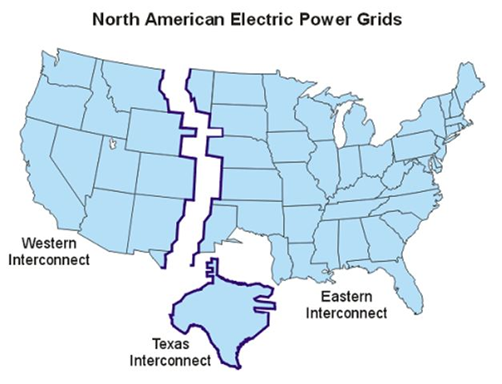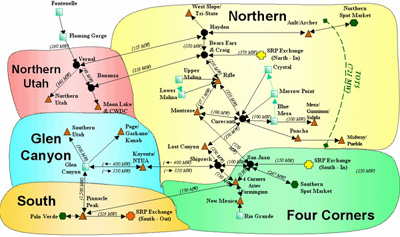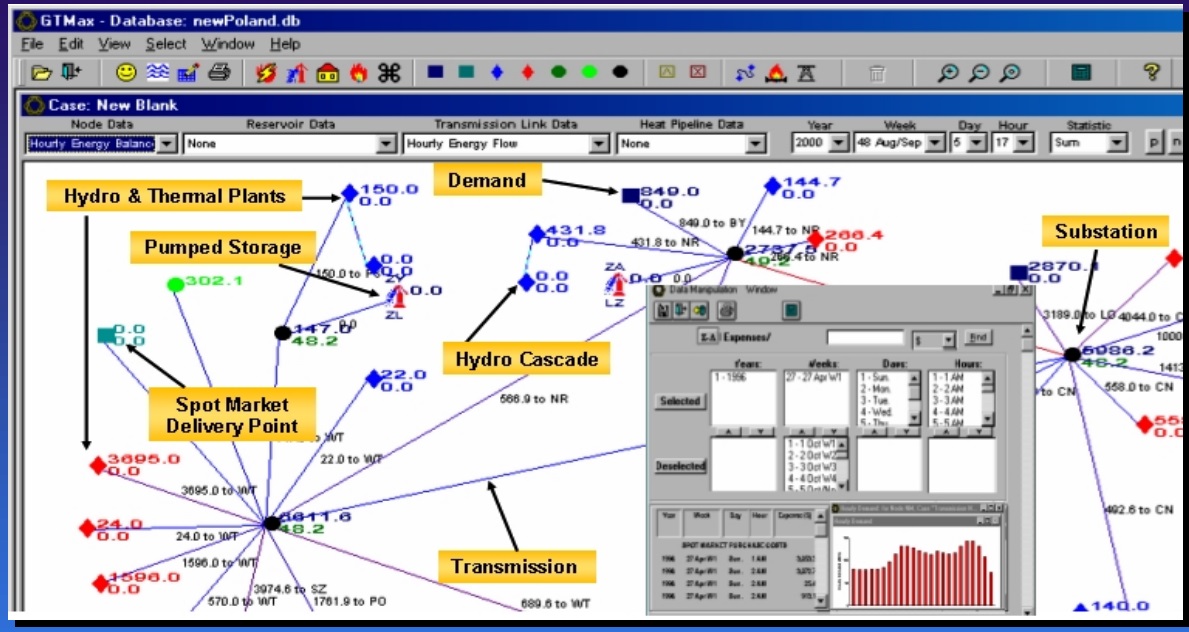|
|
| (7 intermediate revisions by the same user not shown) |
| Line 24: |
Line 24: |
| | |style="width:60%; font-size:120%;"| | | |style="width:60%; font-size:120%;"| |
| | | | |
| − | WAPA and Reclamation use GTMax to analyze the economics of CRSP hydropower systems in the western half of the U.S. power grid (the Western Interconnect). | + | WAPA and Reclamation uses Argonne's GTMax model to analyze the economics of CRSP hydropower systems in the western half of the U.S. power grid (the Western Interconnect). |
| | *GTMax stands for '''G'''eneration and '''T'''ransmission '''Max'''imization | | *GTMax stands for '''G'''eneration and '''T'''ransmission '''Max'''imization |
| − | *GTMax: A model used to analyze power system impacts | + | *GTMax: A model used to guide operators in how to maximize the efficiency in scheduling generation to meet electrical loads. |
| | | | |
| | |}<!-- | | |}<!-- |
| Line 40: |
Line 40: |
| | |class="MainPageBG" style="width:55%; border:1px solid #cef2e0; background:#f5faff; vertical-align:top; color:#000;"| | | |class="MainPageBG" style="width:55%; border:1px solid #cef2e0; background:#f5faff; vertical-align:top; color:#000;"| |
| | {|width="100%" cellpadding="2" cellspacing="5" style="vertical-align:top; background:#f5faff;" | | {|width="100%" cellpadding="2" cellspacing="5" style="vertical-align:top; background:#f5faff;" |
| − | ! <h2 style="margin:0; background:#cedff2; font-size:120%; font-weight:bold; border:1px solid #a3bfb1; text-align:left; color:#000; padding:0.2em 0.4em;">'''Generation and Transmission Maximization (GTMax) Model [https://ceeesa.es.anl.gov/projects/Gtmax.html]'''</h2> | + | ! <h2 style="margin:0; background:#cedff2; font-size:120%; font-weight:bold; border:1px solid #a3bfb1; text-align:left; color:#000; padding:0.2em 0.4em;">'''Generation and Transmission Maximization (GTMax) Model '''</h2> |
| | |- | | |- |
| | |style="color:#000;"| | | |style="color:#000;"| |
| Line 52: |
Line 52: |
| | The GTMax model helps researchers study complex marketing and system operational issues. With the aid of this comprehensive model, utility operators and managers can maximize the value of the electric system, taking into account not only its limited energy and transmission resources, but also firm contracts, independent power producer (IPP) agreements, and bulk power transaction opportunities on the spot market. GTMax maximizes net revenues of power systems by finding a solution that increases income while keeping expenses at a minimum. At the same time, the model ensures that market transactions and system operations remain within the physical and institutional limitations of the power system. When multiple systems are simulated, GTMax identifies utilities that can successfully compete in the market by tracking hourly energy transactions, costs, and revenues. | | The GTMax model helps researchers study complex marketing and system operational issues. With the aid of this comprehensive model, utility operators and managers can maximize the value of the electric system, taking into account not only its limited energy and transmission resources, but also firm contracts, independent power producer (IPP) agreements, and bulk power transaction opportunities on the spot market. GTMax maximizes net revenues of power systems by finding a solution that increases income while keeping expenses at a minimum. At the same time, the model ensures that market transactions and system operations remain within the physical and institutional limitations of the power system. When multiple systems are simulated, GTMax identifies utilities that can successfully compete in the market by tracking hourly energy transactions, costs, and revenues. |
| | | | |
| − | [[Image:Ceeesa ModelsGtmaxRegions.jpg|center|400px]] <br> | + | [[Image:Ceeesa ModelsGtmaxRegions.jpg|center|600px]] <br> |
| | | | |
| | An added benefit of GTMax is that it simulates some limitations, including power plant seasonal capabilities, limited energy constraints, transmission capabilities, and terms specified in firm and IPP contracts. Moreover, GTMax also considers detailed operational limitations, such as power plant ramp rates and hydropower reservoir constraints. Currently, power companies are using GTMax to determine hourly, weekly, and seasonal power and energy offers to customers and to compute the costs of environmental legislation. GTMax can also be used to fine-tune hourly resource generation patterns, spot market transactions, energy interchanges, and power wheeling on the transmission system. | | An added benefit of GTMax is that it simulates some limitations, including power plant seasonal capabilities, limited energy constraints, transmission capabilities, and terms specified in firm and IPP contracts. Moreover, GTMax also considers detailed operational limitations, such as power plant ramp rates and hydropower reservoir constraints. Currently, power companies are using GTMax to determine hourly, weekly, and seasonal power and energy offers to customers and to compute the costs of environmental legislation. GTMax can also be used to fine-tune hourly resource generation patterns, spot market transactions, energy interchanges, and power wheeling on the transmission system. |
| Line 128: |
Line 128: |
| | Demo CD: You can request a CD that contains a 35-minute movie introducing you to the GTMax model if you contact CEEESA. | | Demo CD: You can request a CD that contains a 35-minute movie introducing you to the GTMax model if you contact CEEESA. |
| | You can also contact our GTMax software distributor, ADICA Consulting LLC, to download the demo over the Internet. | | You can also contact our GTMax software distributor, ADICA Consulting LLC, to download the demo over the Internet. |
| − | The full GTMax Professional software is licensed and distributed by Adica Consulting LLC. Please visit their website at www.adica.com for more details. | + | The full GTMax Professional software is licensed and distributed by Adica Consulting LLC. Please visit their website at www.adica.com for more details.[https://ceeesa.es.anl.gov/projects/Gtmax.html] |
| | | | |
| | |} | | |} |
| Line 154: |
Line 154: |
| | *[[Media:GTMax Rpt Final.pdf |GT Max Final Products of 2011 Hydropower KA and GT Max Model review workshop]] | | *[[Media:GTMax Rpt Final.pdf |GT Max Final Products of 2011 Hydropower KA and GT Max Model review workshop]] |
| | *[https://www.usbr.gov/uc/progact/amp/amwg/2010-08-24-amwg-meeting/Attach_02a.pdf AMWG presentation: Socioeconomic Workshop and Panel Report] | | *[https://www.usbr.gov/uc/progact/amp/amwg/2010-08-24-amwg-meeting/Attach_02a.pdf AMWG presentation: Socioeconomic Workshop and Panel Report] |
| − | *[https://www.usbr.gov/uc/progact/amp/twg/2010-11-15-twg-meeting/Attach_08a.pdf Final Report of the GCMRC Socioeconomic Research Review Panel]
| |
| | *[https://www.usbr.gov/uc/progact/amp/pdfs/GTMaxModel/GTMax-Final-Rpt-main.pdf Final Report of the GTMax Model Review Panel] | | *[https://www.usbr.gov/uc/progact/amp/pdfs/GTMaxModel/GTMax-Final-Rpt-main.pdf Final Report of the GTMax Model Review Panel] |
| | *[https://www.usbr.gov/uc/progact/amp/pdfs/GTMaxModel/Workshop-Particip-Resp.pdf Workshop participants' responses to the final report ] | | *[https://www.usbr.gov/uc/progact/amp/pdfs/GTMaxModel/Workshop-Particip-Resp.pdf Workshop participants' responses to the final report ] |
| Line 160: |
Line 159: |
| | | | |
| | |- | | |- |
| − | ! <h2 style="margin:0; background:#cedff2; font-size:120%; font-weight:bold; border:1px solid #a3b0bf; text-align:left; color:#000; padding:0.2em 0.4em;">Presentations and Papers</h2> | + | ! <h2 style="margin:0; background:#cedff2; font-size:120%; font-weight:bold; border:1px solid #a3b0bf; text-align:left; color:#000; padding:0.2em 0.4em;">Does WAPA try to maximize revenues or minimize costs? </h2> |
| | |- | | |- |
| | |style="color:#000;"| | | |style="color:#000;"| |
| | | | |
| − | | + | Excerpt from the [https://www.usbr.gov/uc/progact/amp/pdfs/GTMaxModel/Workshop-Particip-Resp.pdf workshop participants' responses] to the [https://www.usbr.gov/uc/progact/amp/pdfs/GTMaxModel/GTMax-Final-Rpt-main.pdf Final Report of the GTMax Model Review Panel:] |
| − | |-
| + | |
| − | ! <h2 style="margin:0; background:#cedff2; font-size:120%; font-weight:bold; border:1px solid #a3b0bf; text-align:left; color:#000; padding:0.2em 0.4em;">Why WAPA doesn't try to maximize revenues, but instead tries to minimize costs </h2>
| + | |
| − | |-
| + | |
| − | |style="color:#000;"|
| + | |
| | | | |
| | In addition to numerous references to maximizing revenues and improving profits, the author(s) state | | In addition to numerous references to maximizing revenues and improving profits, the author(s) state |
| Line 192: |
Line 187: |
| | As in items 3-4 above, the promotion of false perceptions such as this serves only to establish or | | As in items 3-4 above, the promotion of false perceptions such as this serves only to establish or |
| | strengthen barriers among AMP stakeholders who might otherwise be able to collaborate more | | strengthen barriers among AMP stakeholders who might otherwise be able to collaborate more |
| − | effectively. [https://www.usbr.gov/uc/progact/amp/pdfs/GTMaxModel/Workshop-Particip-Resp.pdf] | + | effectively. [https://www.usbr.gov/uc/progact/amp/pdfs/GTMaxModel/Workshop-Particip-Resp.pdf ] |
| | + | |
| | | | |
| | | | |
Generation and Transmission Maximization (GTMax) Model
|
Background
In the global community, operators and managers are challenged daily by complex and ever-changing physical, environmental, economic, and institutional constraints, especially when determining how to use utility power systems most effectively. In many countries, vertically integrated power systems are being transformed into open power markets in which generation, transmission, and distribution are unbundled. Utility system planners are now recognizing the benefits — economic, financial, and reliability — of entering into power and energy transactions with neighboring countries and systems. These advantages can be realized through firm contracts, spot market transactions, and emergency intertie agreements.
GTMax Design
The GTMax model helps researchers study complex marketing and system operational issues. With the aid of this comprehensive model, utility operators and managers can maximize the value of the electric system, taking into account not only its limited energy and transmission resources, but also firm contracts, independent power producer (IPP) agreements, and bulk power transaction opportunities on the spot market. GTMax maximizes net revenues of power systems by finding a solution that increases income while keeping expenses at a minimum. At the same time, the model ensures that market transactions and system operations remain within the physical and institutional limitations of the power system. When multiple systems are simulated, GTMax identifies utilities that can successfully compete in the market by tracking hourly energy transactions, costs, and revenues.
An added benefit of GTMax is that it simulates some limitations, including power plant seasonal capabilities, limited energy constraints, transmission capabilities, and terms specified in firm and IPP contracts. Moreover, GTMax also considers detailed operational limitations, such as power plant ramp rates and hydropower reservoir constraints. Currently, power companies are using GTMax to determine hourly, weekly, and seasonal power and energy offers to customers and to compute the costs of environmental legislation. GTMax can also be used to fine-tune hourly resource generation patterns, spot market transactions, energy interchanges, and power wheeling on the transmission system.
An added value of the GTMax model is that it produces financial reports, which help dispatchers identify operational strategies to optimize the value of the system's resources, while continuing to take full advantage of market opportunities. The model also allows to define regions for added reporting capabilities as shown in the figure above. Data from GTMax are presented in easy-to-understand tables and graphs, providing information such as which units should be dispatched, how much power should be generated and sold on an hourly basis, when to buy and sell power on the spot market, the cost of alternative power plant operations, the incremental value of water, and the value of demand-side management programs.
GTMax also gives financial market clearing prices, which can be used to determine whether an investment is financially viable, given the prevailing market rules for bidding, capacity credits, and ancillary services. In addition, GTMax looks at locational issues when building new power plants or transmission lines, identifying regions with high marginal values that may be more attractive for future investments.
GTMax example screen
The screen capture below shows the user-friendly geographical information system interface of GTMax. In this Windows-based environment, users can point and click on a map of utility power plants to modify input data and obtain optimization results, while simultaneously viewing two or more scenarios. Hourly energy flows from supply resources such as generators and IPP firm contract purchases to load centers and spot market delivery points are graphically displayed on a map.
Issues Addressed by GTMax
Which units will be dispatched in the new market and which will be stranded?
- How much power will I be able to generate and sell each hour during a particular period?
- When should I consider buying and/or selling power in the spot market?
- What is the marginal value of water in my hydro reservoirs?
- What is the value of demand side management programs?
- What is the projected available transmission capability each hour in the region?
- Will my investment in power or transmission assets provide an attractive return?
- What is the benefit of demand side management and distributed resources?
Strengths of GTMax
- Maximizes company revenues
- Optimizes hydro and thermal generation
- Considers firm contracts and IPP agreements
- Estimates regional economic clearing price of energy
- Simulates spot market transactions
- Quantifies the operational costs and revenues of an IPP
- Models energy exchange agreements
- Smoothly integrates with an OASIS system
- Transmission flows are estimated using a DC-OPF algorithm
- Operates in a convenient and powerful GIS interface
GTMax Applications
GTMax was originally developed for U.S. clients, but because of its ease of use, flexibility and adaptability to other systems, and its powerful analytical capabilities, international applications are growing rapidly. Below are just a few examples of current and/or recent model applications:
- A large U.S. utility company uses GTMax to determine hourly, weekly, and seasonal power and energy offers to customers and fine tune hourly resource generation patterns, spot market transactions, energy interchanges, and power wheeling
- The U.S. Bureau of Reclamation uses GTMax to compute the economic and financial costs associated with environmental restrictions on hydropower operations
- The U.S. Agency for International Development (USAID) in collaboration with CMS Energy purchased 15 licenses of GTMax for distribution to energy companies in the Balkans to help establish a regional *Southeast-European electricity market. CEEESA staff are conducting the market analysis and is providing training and technical support. Click here for more details
- The Modeling Group at the Greek Meteorological Institute has purchased the software to analyze the Greek power market as well as regional integration issues
- The Argentine Nuclear Energy Commission (CNEA) is running GTMax together with the Independent System Operator (CAMESSA) to study the country's power market
- A large U.S. energy marketing office uses GTMax to identify operational strategies that optimize the value of company resources while taking advantage of market opportunities
- A large international power merchant used GTMax to assess the financial viability of two transmission line projects in the Balkans. Click here for more details
- The Polish Energy Market Agency used GTMax to estimate the competitiveness of small gas-fired cogeneration in Poland’s newly restructured energy markets. Click here for more details
- A large U.S. utility company uses GTMax to compute available transmission capabilities for postings on regional Open Access Same-time Information Systems (OASIS)
Training and Capacity Building
We have extensive expertise and experience in capacity building by assisting our ENPEP users around the world in form of training and implementation support. Over the last 20+ years, we have conducted training courses in many locations around the world and have successfully trained over 1200 experts from 87 countries in the use of our tools.
GTMax training courses and workshops can be tailored to your specific needs and can last anywhere between a few days to a couple of weeks. Courses may be held at Argonne's facility in the Chicago area or at your facilities.
Click here for information on past and upcoming training courses or click on the pictures below.
Training and Assistance
Additional Resources: For more information on the model and some of its current applications, download the following brochures, presentations, and papers in pdf format:
In addition, we have a demonstration video available:
Demo CD: You can request a CD that contains a 35-minute movie introducing you to the GTMax model if you contact CEEESA.
You can also contact our GTMax software distributor, ADICA Consulting LLC, to download the demo over the Internet.
The full GTMax Professional software is licensed and distributed by Adica Consulting LLC. Please visit their website at www.adica.com for more details.[1]
|
|
Links
|
|
|
2011 Hydropower KA and GT Max Model review workshop
|
|
|
Does WAPA try to maximize revenues or minimize costs?
|
|
Excerpt from the workshop participants' responses to the Final Report of the GTMax Model Review Panel:
In addition to numerous references to maximizing revenues and improving profits, the author(s) state
that “minimizing costs may not be the most important objective”, and proceed to suggest that
maximizing revenues would constitute a mathematically equivalent approach.
From a WAPA customer perspective, we believe that there is a significant policy-level difference
between a statutory obligation that requires WAPA to market federal project hydropower at the lowest
possible rates to consumers consistent with sound business practices, and a revenue maximization goal.
On one hand, the author(s) correctly observe that the objective function of the GT Max model is to
minimize cost. In this regard, we believe that WAPA and Argonne have correctly oriented the tool so as
to be reflective of WAPA’s legal obligation.
On the other hand, the author(s) describe the business area where 100% of WAPA’s customers reside
as “the regulated IOU business model”, which suggests to us that the author(s) may not understand
the public power characteristics of WAPA’s customers.
The foregoing observations notwithstanding, the real damage in the revenue versus cost discussion is
the promulgation of the misleading suggestion that utility business entities (WAPA, WAPA’s customers,
other public power entities, IOUs, etc.) are exclusively focused on maximizing profits. This is
particularly harmful in the AMP arena, where the majority of participants are not utility business
professionals, and a perception that “profits trump natural resources” could be reinforced.
As in items 3-4 above, the promotion of false perceptions such as this serves only to establish or
strengthen barriers among AMP stakeholders who might otherwise be able to collaborate more
effectively. [2]
|
|


